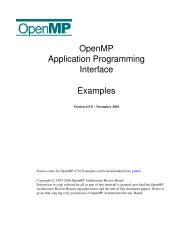D2 3 Computing e-Infrastructure cost calculations and business _models_vam1-final
D2 3 Computing e-Infrastructure cost calculations and business _models_vam1-final
D2 3 Computing e-Infrastructure cost calculations and business _models_vam1-final
You also want an ePaper? Increase the reach of your titles
YUMPU automatically turns print PDFs into web optimized ePapers that Google loves.
e-‐FISCAL: www.efiscal.eu <br />
EC Contract Number: 283449 <br />
Some other underlying issues revealed by the analysis were: <br />
• Hardware depreciation rates are in several cases well above the typical well-‐cited three–year period. The <br />
average depreciation period corresponds to 5 years, <br />
• The Power Usage Effectiveness (PUE) rates are around 1.5 (median value) indicating rather efficient <br />
energy use, <strong>and</strong> <br />
• Approximately 2 FTEs are required for each 1,000 cores (median value). <br />
The analysis also provided evidence of a decreasing trend in <strong>cost</strong>s from year 2010 to 2011. <br />
After assessing the per core hour <strong>cost</strong>s, they are compared with the prices charged by commercial cloud providers <br />
(such as Amazon EC2). The comparison is done in two variants: first without taking into consideration <br />
performance differences between in-‐house service provision <strong>and</strong> commercial cloud services, <strong>and</strong> second by <br />
adjusting for the differences in performance based on the benchmarking results (performance-‐adjusted <strong>cost</strong> <br />
comparisons). The small-‐scale benchmarking exercise included in the project was used to establish range of <br />
performance degradation percentages that correspond to the most relevant in-‐house infrastructure installations <br />
<strong>and</strong> their commercial service counterparts. <br />
By concentrating only on financial considerations, our findings provide strong evidence that cloud prices are not <br />
necessarily <strong>and</strong> unanimously lower than the <strong>cost</strong>s calculated by e-‐FISCAL for in-‐house service provision. This <br />
holds true even without taking into account the differences in the actual service portfolios discussed above. <br />
Parameters like utilization rates, infrastructure size, length of time committed to use cloud services (for example <br />
by using “reserved instances” offered by some of the Cloud vendors), efficiency in manpower utilization <strong>and</strong> <br />
service performance are important factors affecting the basic <strong>cost</strong> relation between cloud <strong>and</strong> e-‐<strong>Infrastructure</strong>s. <br />
Thus <strong>cost</strong> is not synonymous to value; on the contrary <strong>cost</strong> is only one of the parameters that should be <br />
considered in the value creation process. <br />
e-‐FISCAL : Financial Study for Sustainable <strong>Computing</strong> e-‐<strong>Infrastructure</strong>s <br />
Deliverable <strong>D2</strong>.3 – <strong>Computing</strong> e-‐<strong>Infrastructure</strong>s <strong>cost</strong> estimation <strong>and</strong> analysis – Pricing <strong>and</strong> <br />
Business <strong>models</strong> <br />
7




